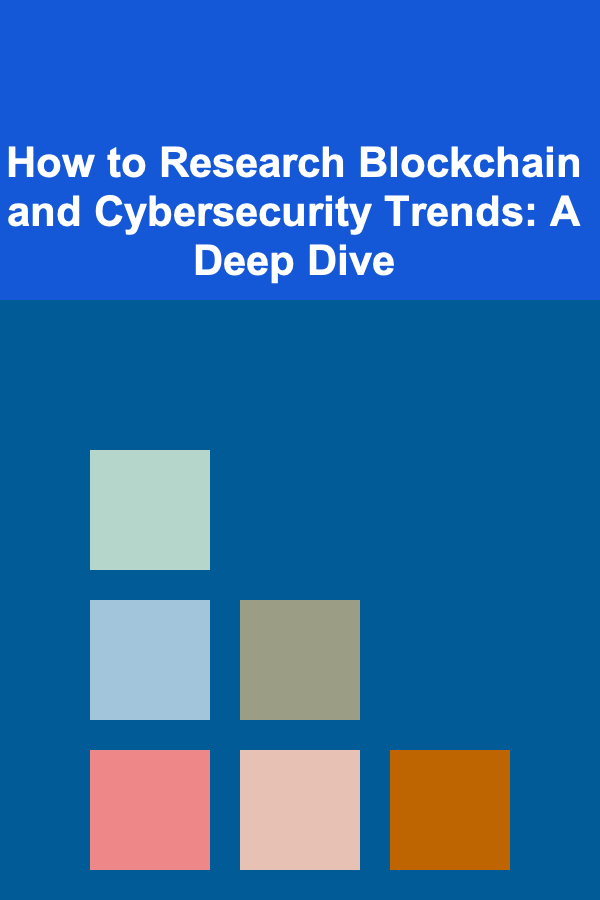
How to Research Blockchain and Cybersecurity Trends: A Deep Dive
ebook include PDF & Audio bundle (Micro Guide)
$12.99$5.99
Limited Time Offer! Order within the next:

The convergence of blockchain technology and cybersecurity presents both exciting opportunities and significant challenges. Blockchain, with its inherent security features and decentralized nature, promises to revolutionize various industries. However, it also introduces new attack vectors and complexities that require robust cybersecurity strategies. Staying informed about the latest trends in both blockchain and cybersecurity is crucial for professionals, researchers, and organizations seeking to leverage blockchain's potential while mitigating its risks.
This article provides a comprehensive guide on how to effectively research blockchain and cybersecurity trends, covering key resources, methodologies, and critical considerations. We will explore strategies for identifying emerging threats, analyzing technological advancements, and understanding the evolving regulatory landscape.
I. Understanding the Landscape: The Interplay of Blockchain and Cybersecurity
Before diving into research methodologies, it's essential to understand the intricate relationship between blockchain and cybersecurity. Blockchain technology offers several security advantages:
- Immutability: Once data is recorded on the blockchain, it becomes extremely difficult to alter or delete, enhancing data integrity.
- Cryptography: Cryptographic techniques like hashing and digital signatures are used to secure transactions and verify identities.
- Decentralization: The distributed nature of blockchain makes it resilient to single points of failure, improving availability.
- Transparency: Transactions are often publicly auditable, fostering accountability and trust (depending on the type of blockchain).
However, blockchain also introduces new cybersecurity challenges:
- 51% Attacks: If a single entity controls more than 50% of the network's hashing power, they can potentially manipulate the blockchain.
- Smart Contract Vulnerabilities: Poorly written smart contracts can contain vulnerabilities that allow attackers to drain funds or disrupt operations. Examples include reentrancy attacks, integer overflows, and denial-of-service attacks.
- Private Key Management: The security of a blockchain system heavily relies on the secure management of private keys. If a private key is compromised, an attacker can access and control associated funds or data.
- Scalability Issues: Some blockchain networks struggle to handle a large volume of transactions, making them susceptible to denial-of-service attacks.
- Regulatory Uncertainty: The evolving regulatory landscape surrounding blockchain and cryptocurrencies creates compliance challenges and potential legal risks.
- Emerging Threats: New attack vectors specifically targeting blockchain infrastructure and applications are constantly emerging.
Understanding these dual aspects -- the security benefits and the inherent risks -- is the foundation for effective research.
II. Identifying Reliable Sources of Information
The information overload in the blockchain and cybersecurity space can be overwhelming. It's crucial to filter out the noise and focus on credible sources. Here's a breakdown of valuable resources:
A. Academic and Research Institutions
- Journals: Look for peer-reviewed journals specializing in cryptography, computer security, and distributed systems. Examples include the Journal of Cryptology, the IEEE Transactions on Information Forensics and Security, and the ACM Transactions on Privacy and Security.
- Conferences: Attend or review proceedings from leading security and blockchain conferences. Key conferences include Black Hat, DEF CON, RSA Conference, IEEE Symposium on Security and Privacy (Oakland), USENIX Security Symposium, and Crypto. For blockchain specifically, consider Consensus, Blockchain Expo, and Devcon.
- University Research Labs: Many universities have dedicated research labs focused on blockchain and cybersecurity. Their websites often publish research papers, reports, and open-source tools. Examples include the Stanford Center for Blockchain Research, the UC Berkeley Blockchain Xcelerator, and the MIT Media Lab's Digital Currency Initiative.
- Preprint Servers: Platforms like arXiv host preprints of research papers before they are formally published in journals. While not peer-reviewed, they can provide early access to cutting-edge research. Exercise caution and critically evaluate the content.
B. Industry Reports and Analyst Firms
- Gartner: Provides in-depth analysis and market research on cybersecurity and emerging technologies, including blockchain. Their Hype Cycle reports can be valuable for understanding the maturity and adoption of different technologies.
- Forrester: Another leading analyst firm offering reports and consulting services related to security and blockchain.
- Deloitte, PwC, EY, KPMG: These "Big Four" accounting firms publish reports and whitepapers on blockchain and cybersecurity trends, often focusing on the business and regulatory implications.
- Cybersecurity Companies: Many cybersecurity vendors publish threat reports, vulnerability analyses, and security advisories. Examples include FireEye, CrowdStrike, Palo Alto Networks, and Rapid7. These reports often provide valuable insights into real-world attacks and vulnerabilities.
- Blockchain Analytics Firms: Companies like Chainalysis, Elliptic, and CipherTrace specialize in analyzing blockchain transactions to identify illicit activities, track stolen funds, and comply with regulations. Their reports can provide valuable insights into the security risks associated with blockchain.
C. Open-Source Projects and Communities
- GitHub: A vast repository of open-source projects related to blockchain and cybersecurity. Reviewing code, contributing to projects, and following discussions can provide valuable learning opportunities.
- Blockchain Foundations: Organizations like the Ethereum Foundation, the Hyperledger Foundation, and the Linux Foundation support the development and adoption of open-source blockchain technologies. Their websites offer resources, documentation, and community forums.
- Security Communities: Participate in online forums, mailing lists, and social media groups dedicated to cybersecurity. Examples include Reddit's r/netsec, the SANS Institute's Internet Storm Center, and OWASP (Open Web Application Security Project).
- Bug Bounty Programs: Companies and projects often offer bug bounty programs to incentivize security researchers to find and report vulnerabilities. Participating in these programs can provide hands-on experience and contribute to the security of blockchain systems.
D. News Outlets and Blogs
- Specialized Publications: Follow news outlets and blogs that focus specifically on blockchain and cybersecurity. Examples include CoinDesk, CoinTelegraph, The Block, Dark Reading, SecurityWeek, and Threatpost.
- Technology News Sites: Major technology news sites like Wired, TechCrunch, and The Verge often cover significant developments in blockchain and cybersecurity.
- Security Blogs: Many security researchers and professionals maintain blogs where they share their insights and analysis of emerging threats and vulnerabilities. Examples include KrebsOnSecurity, Schneier on Security, and Troy Hunt's blog.
E. Regulatory and Governmental Bodies
- SEC (Securities and Exchange Commission): Provides guidance and regulations regarding securities offerings involving blockchain technology and cryptocurrencies.
- CFTC (Commodity Futures Trading Commission): Regulates derivatives trading, including those based on cryptocurrencies.
- FinCEN (Financial Crimes Enforcement Network): Focuses on combating money laundering and other financial crimes related to cryptocurrencies.
- NIST (National Institute of Standards and Technology): Develops cybersecurity standards and guidelines for federal agencies and the private sector, including those related to blockchain.
- ENISA (European Union Agency for Cybersecurity): Provides expertise and guidance on cybersecurity matters in the European Union.
- GDPR (General Data Protection Regulation): While not directly blockchain-specific, GDPR has implications for blockchain applications that process personal data.
Important Considerations When Evaluating Sources:
- Reputation and Credibility: Assess the source's reputation and track record. Are they known for accuracy and objectivity?
- Bias: Be aware of potential biases. Is the source affiliated with a particular company or industry group that might have a vested interest?
- Date of Publication: Blockchain and cybersecurity are rapidly evolving fields. Ensure that the information is current and relevant.
- Methodology: Understand the methodology used to gather and analyze the data. Is it transparent and rigorous?
- Peer Review: Prioritize peer-reviewed sources, especially for academic research.
III. Research Methodologies: A Structured Approach
Once you have identified reliable sources, it's time to adopt a structured approach to your research. Here are several effective methodologies:
A. Literature Reviews
A literature review involves systematically searching, evaluating, and synthesizing existing research on a particular topic. This is a fundamental step in understanding the current state of knowledge and identifying gaps in the literature. Here's how to conduct an effective literature review:
- Define Your Research Question: Clearly articulate the specific question you are trying to answer. For example, "What are the most prevalent smart contract vulnerabilities in decentralized finance (DeFi) applications?" or "How can blockchain technology be used to enhance supply chain security?"
- Develop Search Terms: Identify relevant keywords and search terms related to your research question. Use Boolean operators (AND, OR, NOT) to refine your search. For example, "blockchain AND cybersecurity," "smart contract vulnerabilities AND DeFi," "supply chain AND blockchain AND security."
- Search Databases and Repositories: Search academic databases like IEEE Xplore, ACM Digital Library, Scopus, and Web of Science. Also, explore open-access repositories like arXiv and Google Scholar.
- Evaluate Sources: Critically evaluate the sources you find based on their relevance, credibility, and methodology.
- Synthesize Findings: Summarize and synthesize the key findings from the literature, identifying common themes, conflicting viewpoints, and gaps in the research.
- Cite Your Sources: Properly cite all sources you use to avoid plagiarism and give credit to the original authors. Use a consistent citation style (e.g., APA, MLA, Chicago).
B. Threat Modeling
Threat modeling is a systematic process of identifying and evaluating potential threats to a system or application. It helps to prioritize security efforts and develop mitigation strategies. Here's a simplified overview of the threat modeling process:
- Identify Assets: Determine the critical assets that need to be protected, such as data, funds, infrastructure, and reputation.
- Identify Threats: Identify potential threats to those assets. This can involve brainstorming, reviewing past incidents, and consulting threat intelligence reports. Examples include:
- Injection Attacks: Exploiting vulnerabilities in smart contract input validation.
- Denial-of-Service (DoS) Attacks: Overwhelming the blockchain network with traffic.
- Sybil Attacks: Creating multiple fake identities to gain control of the network.
- Phishing Attacks: Targeting users to steal their private keys.
- 51% Attacks: Gaining control of the majority of the network's hashing power.
- Assess Vulnerabilities: Identify vulnerabilities that could be exploited by the identified threats. This can involve code reviews, penetration testing, and vulnerability scanning.
- Analyze Risks: Assess the likelihood and impact of each threat, considering the vulnerabilities present.
- Develop Mitigation Strategies: Develop strategies to mitigate the identified risks. This can involve implementing security controls, patching vulnerabilities, and improving security awareness.
- Document and Review: Document the threat model and review it regularly to ensure it remains relevant and effective.
C. Vulnerability Analysis
Vulnerability analysis involves identifying and assessing vulnerabilities in software, hardware, and network infrastructure. This is a crucial step in securing blockchain systems and applications. Here are some common techniques for vulnerability analysis:
- Code Reviews: Manually reviewing source code to identify potential vulnerabilities. This requires a deep understanding of programming languages, security principles, and common coding errors. Focus specifically on areas dealing with user input, cryptographic operations, and network communication.
- Static Analysis: Using automated tools to analyze source code for potential vulnerabilities without executing the code. These tools can identify common coding errors, security flaws, and compliance violations. Examples include SonarQube, Fortify, and Checkmarx.
- Dynamic Analysis (Penetration Testing): Simulating real-world attacks to identify vulnerabilities and assess the effectiveness of security controls. This involves actively probing the system for weaknesses and attempting to exploit them. Ethical hackers perform penetration testing with the permission of the system owner.
- Fuzzing: Providing random or malformed inputs to a program to identify crashes, errors, and vulnerabilities. This is a powerful technique for discovering unexpected behavior and uncovering hidden flaws.
- Vulnerability Scanning: Using automated tools to scan systems and networks for known vulnerabilities. These tools compare the system's configuration and software versions against a database of known vulnerabilities. Examples include Nessus, OpenVAS, and Qualys.
D. Trend Analysis
Trend analysis involves tracking and analyzing emerging trends in blockchain and cybersecurity to anticipate future developments and potential threats. Here are some tips for conducting effective trend analysis:
- Monitor Key Sources: Regularly monitor the sources identified in Section II to stay informed about the latest developments.
- Attend Conferences and Webinars: Attend industry conferences and webinars to learn from experts and network with other professionals.
- Follow Social Media: Follow influencers, researchers, and organizations on social media to stay up-to-date on breaking news and emerging trends.
- Use Trend Analysis Tools: Utilize trend analysis tools like Google Trends and social media monitoring platforms to track the popularity of different keywords and topics.
- Analyze Data: Analyze the data you collect to identify patterns, trends, and potential disruptions. Look for emerging technologies, new attack vectors, and changes in the regulatory landscape.
- Document Your Findings: Document your findings in a clear and concise manner, including the sources you used and the conclusions you reached.
E. Case Studies and Post-Mortem Analysis
Analyzing past security incidents and breaches in the blockchain space is a valuable way to learn from mistakes and improve security practices. Case studies and post-mortem analyses provide detailed accounts of what happened, why it happened, and what steps were taken to address the incident. Look for publicly available reports and analyses from reputable sources. Focus on understanding the root causes of the incident, the vulnerabilities that were exploited, and the lessons learned.
IV. Key Areas of Focus for Research
Given the breadth of blockchain and cybersecurity, it's helpful to focus your research on specific areas of interest. Here are some key areas to consider:
A. Smart Contract Security
Smart contracts are self-executing agreements stored on the blockchain. Securing smart contracts is crucial because vulnerabilities can lead to significant financial losses and reputational damage. Research should focus on:
- Common Vulnerabilities: Reentrancy attacks, integer overflows, denial-of-service attacks, timestamp dependency issues, and access control flaws.
- Security Auditing Tools and Techniques: Static analysis tools, formal verification methods, and manual code review best practices.
- Secure Coding Practices: Best practices for writing secure smart contracts, including input validation, error handling, and access control.
- Formal Verification: Using mathematical methods to prove the correctness of smart contract code.
B. Consensus Mechanism Security
The consensus mechanism is the algorithm that allows a blockchain network to agree on the validity of transactions. The security of the consensus mechanism is critical for maintaining the integrity and availability of the blockchain. Research should focus on:
- Byzantine Fault Tolerance (BFT): Understanding different BFT algorithms and their security properties.
- Proof-of-Work (PoW) Security: Analyzing the vulnerabilities of PoW-based blockchains, such as 51% attacks and selfish mining.
- Proof-of-Stake (PoS) Security: Evaluating the security of PoS-based blockchains, including staking attacks and long-range attacks.
- Delegated Proof-of-Stake (DPoS) Security: Understanding the potential vulnerabilities and centralization risks in DPoS systems.
C. Cryptocurrency Exchange Security
Cryptocurrency exchanges are often targeted by hackers due to the large amounts of cryptocurrency they hold. Research should focus on:
- Common Attack Vectors: Phishing attacks, malware infections, API vulnerabilities, and insider threats.
- Security Best Practices: Multi-factor authentication, cold storage of funds, penetration testing, and security audits.
- Regulatory Compliance: Understanding and complying with regulations related to anti-money laundering (AML) and know your customer (KYC).
- Decentralized Exchanges (DEXs) Security: Investigating the specific security challenges posed by DEXs, such as front-running and impermanent loss attacks.
D. Identity Management on Blockchain
Blockchain can be used to create decentralized identity management systems, but these systems must be carefully designed to protect user privacy and security. Research should focus on:
- Self-Sovereign Identity (SSI): Understanding the principles and technologies behind SSI.
- Privacy-Preserving Techniques: Exploring techniques like zero-knowledge proofs and verifiable credentials.
- Decentralized Key Management: Developing secure and user-friendly methods for managing private keys.
- Compliance with Privacy Regulations: Ensuring that blockchain-based identity management systems comply with regulations like GDPR.
E. Quantum Computing and Blockchain Security
The advent of quantum computing poses a significant threat to many of the cryptographic algorithms used to secure blockchain systems. Research should focus on:
- Post-Quantum Cryptography: Studying new cryptographic algorithms that are resistant to attacks from quantum computers. Examples include lattice-based cryptography, code-based cryptography, and multivariate cryptography.
- Quantum Key Distribution (QKD): Exploring QKD as a potential solution for secure key exchange.
- Hybrid Approaches: Developing hybrid cryptographic systems that combine classical and quantum-resistant algorithms.
- The Impact on Specific Blockchains: Assessing the vulnerability of different blockchain platforms to quantum attacks and developing mitigation strategies.
V. Staying Ahead of the Curve: Continuous Learning and Adaptation
The fields of blockchain and cybersecurity are constantly evolving. To stay ahead of the curve, it's crucial to embrace continuous learning and adapt your research methodologies as new technologies and threats emerge. Here are some tips for maintaining your knowledge:
- Dedicate Time for Research: Schedule regular time for research and learning. Even a few hours each week can make a significant difference.
- Build a Network: Connect with other professionals in the field to share knowledge and learn from each other.
- Experiment with New Technologies: Hands-on experience is invaluable. Experiment with new blockchain platforms, security tools, and attack techniques.
- Obtain Certifications: Consider obtaining certifications in relevant areas, such as Certified Information Systems Security Professional (CISSP), Certified Ethical Hacker (CEH), or Certified Blockchain Professional (CBP).
- Share Your Knowledge: Sharing your knowledge with others can help solidify your understanding and contribute to the community. Consider writing blog posts, giving presentations, or contributing to open-source projects.
VI. Conclusion
Researching blockchain and cybersecurity trends is a continuous and challenging endeavor, but it's essential for anyone working in these rapidly evolving fields. By utilizing the resources, methodologies, and areas of focus outlined in this article, you can develop a deeper understanding of the complex interplay between blockchain and cybersecurity and stay informed about the latest threats and opportunities. Remember to critically evaluate information, adapt your approach as needed, and embrace continuous learning to maintain a competitive edge and contribute to a more secure and innovative future for blockchain technology.

How to Install Soundproofing Windows on a Tight Budget
Read More
How to Soundproof Your Home to Prevent Hearing Loss
Read More
How To Practice Thoughtful Gestures of Love
Read More
How to Advocate for Protected Areas Expansion
Read More
How to Manage Your Credit Cards During a Job Loss
Read More
How to Track Dental Insurance Expenses for Specific Procedures (Implants, Invisalign, etc.)
Read MoreOther Products

How to Install Soundproofing Windows on a Tight Budget
Read More
How to Soundproof Your Home to Prevent Hearing Loss
Read More
How To Practice Thoughtful Gestures of Love
Read More
How to Advocate for Protected Areas Expansion
Read More
How to Manage Your Credit Cards During a Job Loss
Read More